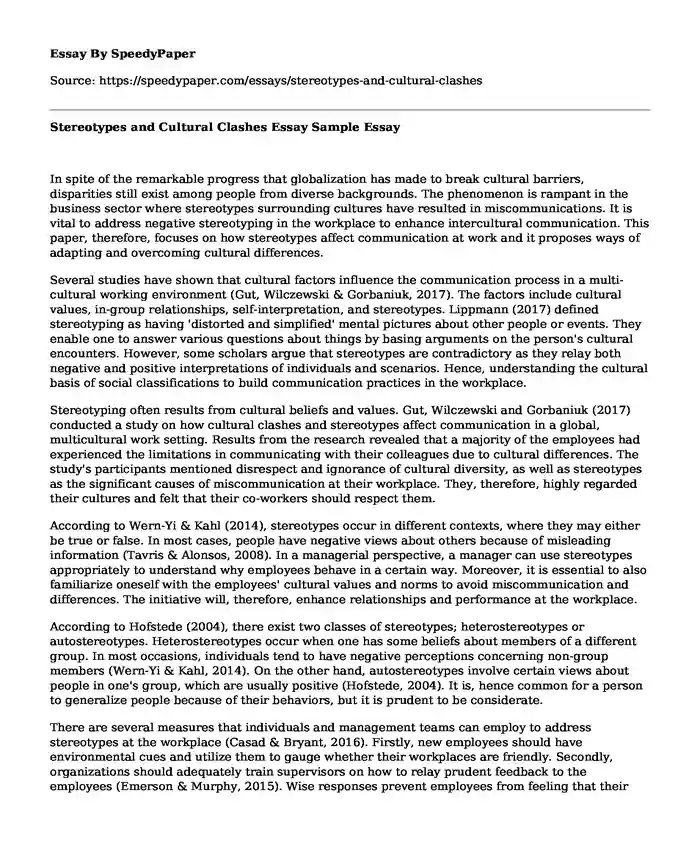
| Type of paper: | Essay |
| Categories: | Culture Multiculturalism Stereotypes Diversity |
| Pages: | 3 |
| Wordcount: | 765 words |
In spite of the remarkable progress that globalization has made to break cultural barriers, disparities still exist among people from diverse backgrounds. The phenomenon is rampant in the business sector where stereotypes surrounding cultures have resulted in miscommunications. It is vital to address negative stereotyping in the workplace to enhance intercultural communication. This paper, therefore, focuses on how stereotypes affect communication at work and it proposes ways of adapting and overcoming cultural differences.
Several studies have shown that cultural factors influence the communication process in a multi-cultural working environment (Gut, Wilczewski & Gorbaniuk, 2017). The factors include cultural values, in-group relationships, self-interpretation, and stereotypes. Lippmann (2017) defined stereotyping as having 'distorted and simplified' mental pictures about other people or events. They enable one to answer various questions about things by basing arguments on the person's cultural encounters. However, some scholars argue that stereotypes are contradictory as they relay both negative and positive interpretations of individuals and scenarios. Hence, understanding the cultural basis of social classifications to build communication practices in the workplace.
Stereotyping often results from cultural beliefs and values. Gut, Wilczewski and Gorbaniuk (2017) conducted a study on how cultural clashes and stereotypes affect communication in a global, multicultural work setting. Results from the research revealed that a majority of the employees had experienced the limitations in communicating with their colleagues due to cultural differences. The study's participants mentioned disrespect and ignorance of cultural diversity, as well as stereotypes as the significant causes of miscommunication at their workplace. They, therefore, highly regarded their cultures and felt that their co-workers should respect them.
According to Wern-Yi & Kahl (2014), stereotypes occur in different contexts, where they may either be true or false. In most cases, people have negative views about others because of misleading information (Tavris & Alonsos, 2008). In a managerial perspective, a manager can use stereotypes appropriately to understand why employees behave in a certain way. Moreover, it is essential to also familiarize oneself with the employees' cultural values and norms to avoid miscommunication and differences. The initiative will, therefore, enhance relationships and performance at the workplace.
According to Hofstede (2004), there exist two classes of stereotypes; heterostereotypes or autostereotypes. Heterostereotypes occur when one has some beliefs about members of a different group. In most occasions, individuals tend to have negative perceptions concerning non-group members (Wern-Yi & Kahl, 2014). On the other hand, autostereotypes involve certain views about people in one's group, which are usually positive (Hofstede, 2004). It is, hence common for a person to generalize people because of their behaviors, but it is prudent to be considerate.
There are several measures that individuals and management teams can employ to address stereotypes at the workplace (Casad & Bryant, 2016). Firstly, new employees should have environmental cues and utilize them to gauge whether their workplaces are friendly. Secondly, organizations should adequately train supervisors on how to relay prudent feedback to the employees (Emerson & Murphy, 2015). Wise responses prevent employees from feeling that their employers are biased, especially if they belong to minority groups. Thirdly, companies should enhance the representation of diverse groups to improve inclusivity (Walton, Logel, Peach, Spencer & Zanna, 2015). Finally, organizations can deal with stereotypes by actively engaging all the employees to discuss the issue and, hence, ensure that they discourage stereotyping at work.
In conclusion, cultural differences are present in the workplace in spite of the impacts of globalization. Stereotypes are one of the primary consequences of cultural disparities in the workplace. Stereotyping causes miscommunication and is a threat to employees' performance. It is, therefore, vital to acknowledge diversity, appreciate people's cultures, and work towards enhancing intercultural relations.
References
Casad, B. J., & Bryant, W. J. (2016). Addressing stereotype threat is critical to diversity and inclusion in organizational psychology. Frontiers in psychology, 7, 8.
Emerson, K. T., & Murphy, M. C. (2015). A company I can trust? Organizational lay theories moderate stereotype threat for women. Personality and Social Psychology Bulletin, 41(2), 295-307.
Gut, A., Wilczewski, M., & Gorbaniuk, O. (2017). Cultural differences, stereotypes and communication needs in intercultural communication in a global multicultural environment. The Employees' perspective. Journal of Intercultural Communication, 43.
Lippmann, W. (2017). Public opinion. Routledge.
Tavris, C., & Aronson, E. (2008). Mistakes were made (but not by me): Why we justify foolish beliefs, bad decisions, and hurtful acts. Houghton Mifflin Harcourt.
Walton, G. M., Logel, C., Peach, J. M., Spencer, S. J., & Zanna, M. P. (2015). Two brief interventions to mitigate a "chilly climate" transform women's experience, relationships, and achievement in engineering. Journal of Educational Psychology, 107(2), 468.
Wern-Yi, G. A. T., & Kahl, C. (2014). "Being Malaysian does not Mean Being Malaysian"-Cultural Stereotypes is a Hindrance to Modern Hospitality Management. Procedia-Social and Behavioral Sciences, 144, 296-305.
Cite this page
Stereotypes and Cultural Clashes Essay Sample. (2022, Nov 21). Retrieved from https://speedypaper.com/essays/stereotypes-and-cultural-clashes
Request Removal
If you are the original author of this essay and no longer wish to have it published on the SpeedyPaper website, please click below to request its removal:
- Free Essay on the Steps to Ensuring Employees Occupational Health and Safety
- Essay Sample on the Summary of the Article SLEEP
- Free Essay on Nest Egg - Saving and Investment Plan
- Biology Essay Example: Standard Differentiation Hierarchy
- Essay Example Dedicated to Evidence-Based Practice in Diabetes
- Essay Sample on A Feasibility Analysis of a Business
- Essay Sample. Analysis of Feral, North Carolina 1965
Popular categories




